| Article ID | Journal | Published Year | Pages | File Type |
|---|---|---|---|---|
| 5104213 | Resources Policy | 2017 | 7 Pages |
Abstract
Mercury is a toxic pollutant that distributes globally once emitted into the air. Mercury emission is the primary environmental impact of small-scale and artisanal gold mining, which are responsible for nearly half of anthropogenic mercury emissions each year. Considering that small-scale, artisanal, and formal gold mining are linked by the global gold price, this analysis evaluates the question - In dollar terms, what is the difference in mercury emission impact, per ounce of gold production, from these three forms of mining? To answer this question, a calibrated benefit transfer approach is employed to apply environmental valuation literature estimates (of mercury's impact on global earnings) to twelve gold mining sites around the world. The results indicate a mean impact range of <$1-$5 for two formally operated open-pit mines in Nevada, $200-$600 for small-scale and artisanal sites that concentrate gold ore prior to mercury amalgamation, and $500-$3200 for small-scale and artisanal sites that amalgamate all of the ore. Given the vast disparity between impact per ounce estimates, even small leakages in gold production from formal to informal operations could increase the net environmental impact of global gold production. Future research ought to estimate this leakage rate by modeling small-scale and artisanal miners' price elasticity of supply.
Related Topics
Physical Sciences and Engineering
Earth and Planetary Sciences
Economic Geology
Authors
Andrew L. Gulley,
